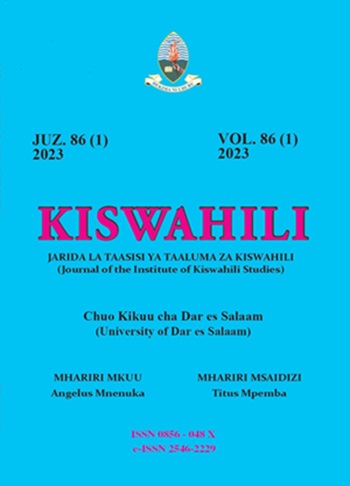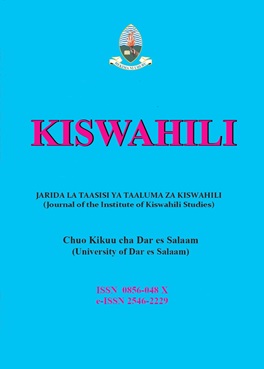A Systematic Description of Imbrication in Nyakyusa
Abstract
This paper offers a systematic description of imbrication in Nyakyusa (M31). The review of literature indicates that, in Nyakyusa, imbrication, a phonological change involving the opaque difference between the input and output forms in -ile suffix, has not been systematically described. It offers this description by identifying triggering conditions and reconstructing the phonological processes shaping imbrication. Data for this paper were collected in Kyela District through a review of written texts, narrative stories, observation and interviews. The findings indicate that the size and syllable structure of the verb are the main determinants of imbrication in Nyakyusa. Quite obviously the process of imbrication involves deletion of the consonant in -ile, followed by metathesis whereby the last consonant of the stem fills the empty slot caused by the deletion of [l]. Then various adjustments that follow i.e. vowel coalescence, vowel deletion, vowel raising, leftward spread of vowel and vowel lengthening are meant to resolve hiatus. The paper concludes that, based on the review of literature, although imbrication is common in some Bantu languages, we noted some conditions and phonological processes shaping imbrication to be language specific. In this view, this paper recommends a systematic comparative description of imbrication in Bantu languages.
References
Bastin, Y. (1983). La finale-IDE et l ' imbrication en Bantou. (Annales, 114.) Tervuren: Musée Royale de TAfrique Centrale.f
Croft, W. (2000). Explaining Language Change: An Evolutionary Approach. London: Longman.
Felberg, K. (1996). Nyakyusa-English-Swahili & English-Nyakyusa Dictionary. Dar es Salaam: Mkuki na Nyota Publishers.
Givon, T. (1970). On ordered rules and the modified base of ChiBemba verbs. African Studies 29: 47-54.
Hayes, B. (2009). Introductory phonology. Oxford: Wiley-Blackwell.
Hyman, L. M. (2007). Reconstruction of the Proto-Bantu verb unit: Internal evidence. SOAS Working Pepers in Linguistics, 15, 201-211.
Hyman, L. M. (1995). Minimality and the prosodic morphology of Cibemba imbrication. Journal of African Languages & Linguistics, 16, (1): 3 €“39.
Keller, R. (1994) On Language Change: The Invisible Hand in Language. London: Routledge.
LOT, (2009). Atlasi ya Lugha za Tanzania. Dar es Salaam: Chuo Kikuu Cha Dar es Salaam.
Massamba, D. P. B. (2010). Phonological theory: history and development (Revised edition). Dar es Salaam: Institute of Kiswahili studies.
Mazrui, A. M. (1983). Aspect marking in Swahili: Accounting for variation. Journal of the Institute of Kiswahili Research, 50 (2): 18-27.
Meeussen, A. E. (1967). Bantu grammatical reconstructions. In Africana Linguistica 3, 9-121.
Kahigi, K. K. (1989). Development affecting the Bantu perfective in *-ile: Another view. Journal of the Institute of Kiswahili Research, 56, 92-107.
Kotzé, A. E. (2008). Making sense of irregular realizations of the past tense suffix in Northern Sotho: The phonology-morphology interface. Southern African Linguistics and Applied Language Studies, 26, (2), 217-234.
Kula, N. C. (2001). Imbrication in Bemba. In Hume, E., Smith, N & van de Weijer, J. (eds.). Surface Syllable Structure and Segmental Sequencing, HIL, Occasional Papers: 102-116.
Morrison, M. (2012 March). Imbrication in Bena. 43rd Annual Conference on African Linguistics. University of Maryland, CASL
Mould, M. (1972). One reconstruction of the modified base of Bantu verbs. Studies in African Linguistics, 3 (1), 107-125.
Persohn, B. (2017). The verb in Nyakyusa: A focus on tense, aspect and modality (Contemporary African Linguistics 2). Berlin: Language Science Press.
Robinson, N. (2015). The -ile suffix and the distinction between tense and aspect in Nyakyusa. Unpublished M. A. Dissertation. University of Dar es Salaam.
Robinson, N. (2016). Word formation: the description of the Nyakyusa derivation and Inflection. International Journal of Language and Linguistics 3, (5), 62-72.
Robinson, N. (2019). The Phonetic Manifestation of -ile suffix across Bantu Languages: The Case of Nyasa-Tanganyika Corridor. Journal of Linguistics and Language in Education, 13, (2), 66-89.
Robinson, N. (2021). Historical evolution of -ile suffix across Bantu languages: The Case of Nyasa-Tanganyika Corridor. Unpublished Doctoral thesis. University of Dar es Salaam.
Rugemalira, J. M. (2005). A Grammar of Runyambo. Dar es Salaam: Languages of Tanzania Project.



